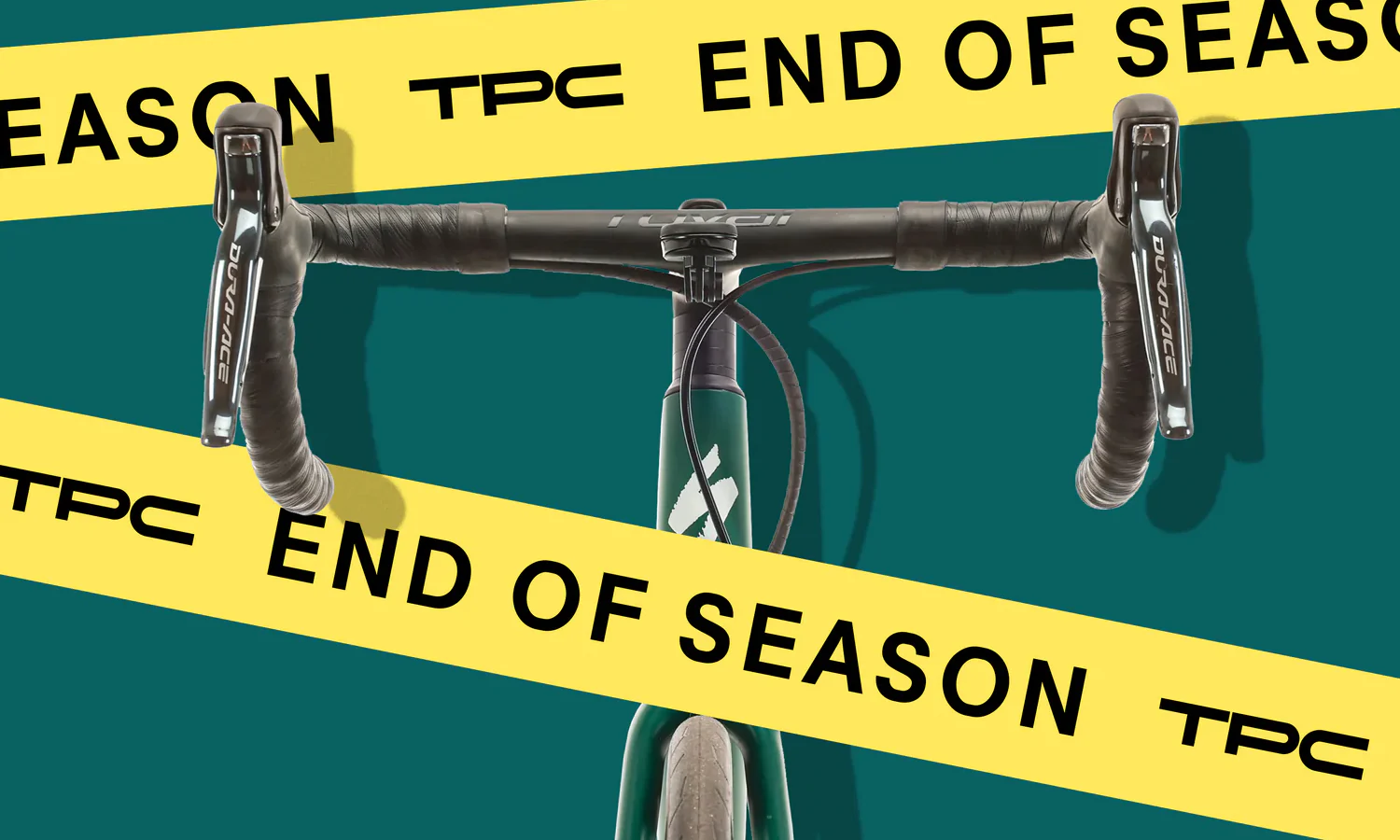Shimano and SRAM are the two dominant component manufacturers in the cycling industry, and the vast majority of modern bikes are going to come with one of their drivetrains.
Some riders are loyal to one brand over the other based on personal experiences, ergonomic preferences, tech preferences, race results, or even something as simple as looks. For picky riders, whether a bike is built with Shimano or SRAM can be a major factor in their purchasing decisions.
We can't definitively answer whether one is “better” than the other (sorry). Instead, This comparison aims to shed light on the similarities and differences between the two brands and their products.
Contents
- Shimano vs. SRAM in 2024
- Key Points When Comparing Shimano vs. SRAM
- Shimano & SRAM Component Hierarchy
- Gearing
- 1x Drivetrains
- Rear Derailleurs
- Shifters
- Cassettes and Freehubs
- Crankarms
- Electronic Drivetrains
- Hydraulic Disc Brakes
- History and Mission
- Technological Innovations
- Industry Popularity
- Final thoughts
Shimano vs. SRAM in 2024
For 2024, we don't expect huge changes, but Shimano and SRAM will likely update many of their current offerings.
Shimano has already introduced its semi-wired 12-speed Di2 Dura-Ace, Ultegra, and 105 road groups, but many riders are still waiting for a Di2 version of 12-speed GRX for gravel bikes and 12-Speed XTR or Deore XT for mountain bikes. We'll see if that materializes in 2024.
SRAM is expected to make some refreshes to its current 12-speed AXS road and gravel groups. There likely won't be huge changes to the road groups, but rather, subtle refinements to the individual components (e.g., shifter shape, power meters, gearing options). We are, however, anticipating a pretty significant update to SRAM's 1x XPLR gravel group later this year, so stay tuned.
Since XX, X0, and GX T-Type Transmissions came out in 2023, we don't anticipate any big additions on the mountain bike drivetrain side. SRAM has further updated its MTB brake line-up with release of the gravity-oriented Maven brakes this year. Interestingly, it uses mineral oil instead of DOT fluid.
Perhaps the biggest product release this year is SRAM's RockShox Flight Attendant suspension system for XC bikes, which should get plenty of attention this year thanks to the Olympics. This high-tech electronic suspension system will be followed by some new budget-oriented fork models too, so stay tuned for that.
The State of the Market: Shimano Needs to Step Up!
In general, SRAM has been stealing significant marketshare from Shimano over the last couple of years. In 2023, we saw SRAM-equipped bikes win all three Grand Tours, including the Tour de France. Bora-Hansgrohe has also confirmed a switch to SRAM for the 2024 season, marking SRAM's fourth WorldTour team. Shimano has traditionally dominated road cycling, but SRAM is now a serious rival.
SRAM's innovative T-Type Transmissions have become the hottest mountain bike drivetrain available and most brands are choosing SRAM Transmission for their top-spec builds. Shimano's 12-speed mechanical Deore and SLX groups are still better budget options, but at the high-end, SRAM is leaving Shimano behind.
We've also noticed that more and more gravel bike manufacturers and riders are also choosing to use 1x SRAM AXS drivetrains. To stay competitive in 2024, Shimano really needs to bring out its latest 12-speed Di2 groups for gravel and mountain bikes this year to provide a competitive alternative to SRAM AXS.
Currently, 12-speed GRX Di2 is the next big release, and we expect it early this year. We also anticipate updated Di2 12-speed MTB groups too. There are also rumors of Shimano getting into the MTB suspension game with AI-powered suspension adjust. We'll see what materializes!
Key Points When Comparing Shimano vs. SRAM
Shimano and SRAM have been competing for the last 30 years. Competition has bred many fantastic cycling components. This section covers some of the key tech and design differences in certain Shimano and SRAM components. First, here's a brief overview of those differences:

|
|
|
| Cable-actuated road shifters |
STI (Shimano Total Integration) |
DoubleTap |
| Electronic drivetrains | Di2 (wired or semi-wired) | eTap AXS, Eagle AXS, T-Type Transmission (wireless) |
| Crankarm material | Alloy | Alloy or Carbon fiber |
| Bottom bracket spindle | Hollowtech II | DUB |
| Freehubs |
Hyperglide or Micro Spline (12spd) |
XD (MTB) or XDR (road) |
| Disc brake fluid | Mineral oil | DOT |
- Shimano has been making bike components for 100 years, while SRAM is much younger than its Japanese competitor, having opened shop in 1987 in Chicago.
- Shimano is more than twice the size of SRAM and dominates original parts spec on road bikes. However, more mountain bikes are outfitted with SRAM components.
- Shimano began selling electronic drivetrains in 2009, six years before SRAM. It's Di2 shifting technology is primarily wired, although the latest Dura-Ace, Ultegra, and 105 Di2 groups are partially wireless.
- AXS is SRAM's marquee electronic shifting technology, and it is an entirely wireless system.
- While SRAM's electronic shifting technology is increasingly common on gravel and mountain bikes, Shimano's application of Di2 shifting in the off-road market has been more limited.
Shimano & SRAM Component Hierarchy
 |
 |
|||
|
Shimano Road |
Shimano MTB |
SRAM Road |
SRAM MTB |
|
|
Entry-level |
Tiagra |
Deore |
Apex |
SX & NX |
|
Mid-range |
105 |
SLX |
Rival |
GX |
|
High-end |
Ultegra |
XT |
Force |
X01 / X0 |
|
Top-of-the-line |
Dura-Ace |
XTR |
Red |
XX1 / XX |
Road Gearing: Shimano Traditional vs. SRAM X-Range

| Traditional road | SRAM X-Range | |
| Chainring options | 54/40t, 53/39t, 52/36t, 50/34t | 50/37t, 48/35t, 46/33t |
| Cassette options | 11-23t, 11-25t, 11-28t, 11-30t, 11-32t, 11-34t, 11-36t |
10-26t, 10-28t, 10-33t, 10-36t |
With its latest AXS 12-speed groups, SRAM has challenged the traditional gearing that's been used on road bikes for decades. The new eTap AXS 12-speed group uses an entirely new gearing system, X-Range. It is intended to reduce front shifting, allowing riders to stay in the big ring for longer. It does so by shrinking the chainring size and using cassettes with 10-tooth cogs and smaller steps between cogs. Shimano currently still uses traditional gearing, which has seen great success over the years. Only time will tell whether X-Range will overtake traditional gearing. 
Photo Courtesy SRAM
Gravel Gearing

| Shimano | SRAM | |
| Chainrings | 1x, or 2x: 48/31t, 46/30t | 1x, or 2x: 46/33t, 43/30t |
| Cassettes | 11-30t, 11-32t, 11-34t, 11-36t, 11-40t, 11-42t, 10-45t | 10-36t, 10-42t, 10-44t, 10-50t, 10-52t |
For gravel bikes, Shimano’s gravel-specific GRX group offers a couple unique gearing options — 48/31t and 46/30t double chainrings. These have a large delta (the difference in tooth count between chainrings) which provide a wide gearing range for off-road riding. GRX is also offered in a 1x configuration. The latest 12-speed mechanical version of GRX provides even more gear range to compete with SRAMs offerings and will use Shimano's 10-45t mountain bike cassette.
SRAM's 11-speed 1x groups (Apex 1, Rival 1, Force 1) are a great affordable options for gravel bikes. Many newer mid- to high-end gravel bikes now use SRAM's 12-speed AXS groups either the 46/33t chainrings, or the gravel-specific 43/30t chainrings.
Of course, there are plenty of 12-speed SRAM 1x options as well. In 2021, SRAM launched a gravel-specific group called XPLR. This is a single-chainring AXS drivetrain designed for a 10-44t cassette. AXS shifters are also compatible with Eagle AXS mountain bike derailleurs, which allow rider to create a "mullet" configuration with a road chainring and Eagle rear derailleur and a 10-50t or 10-52t cassette.
Mountain Bike Gearing

| Shimano MTB | SRAM Eagle | |
| Chainrings | 1x | 1x |
| Cassettes | 10-45t, 10-51t | 10-50t, 10-52t |
On mountain bikes, SRAM's 11-speed XX1 drivetrain with its 10-42T cassette created a whole new generation of wide-range mountain bike cassettes. Shimano responded to SRAM with its own 11-speed 1x drivetrains using 11-40T, 11-42T, and 11-46T cassettes.
Then came the introduction of SRAM’s 12-speed Eagle drivetrain with a 10-50T cassette, which solidified the 1x drivetrain as the dominant option for mountain bikes. Shimano has responded with its own 12-speed drivetrain using a slightly larger 10-51T cassette. Not to be outdone, SRAM now offers a 10-52T cassette for Eagle drivetrains. Chainrings that are commonly paired with these wide-range cassettes range in size from 28-36T.
1x Drivetrains
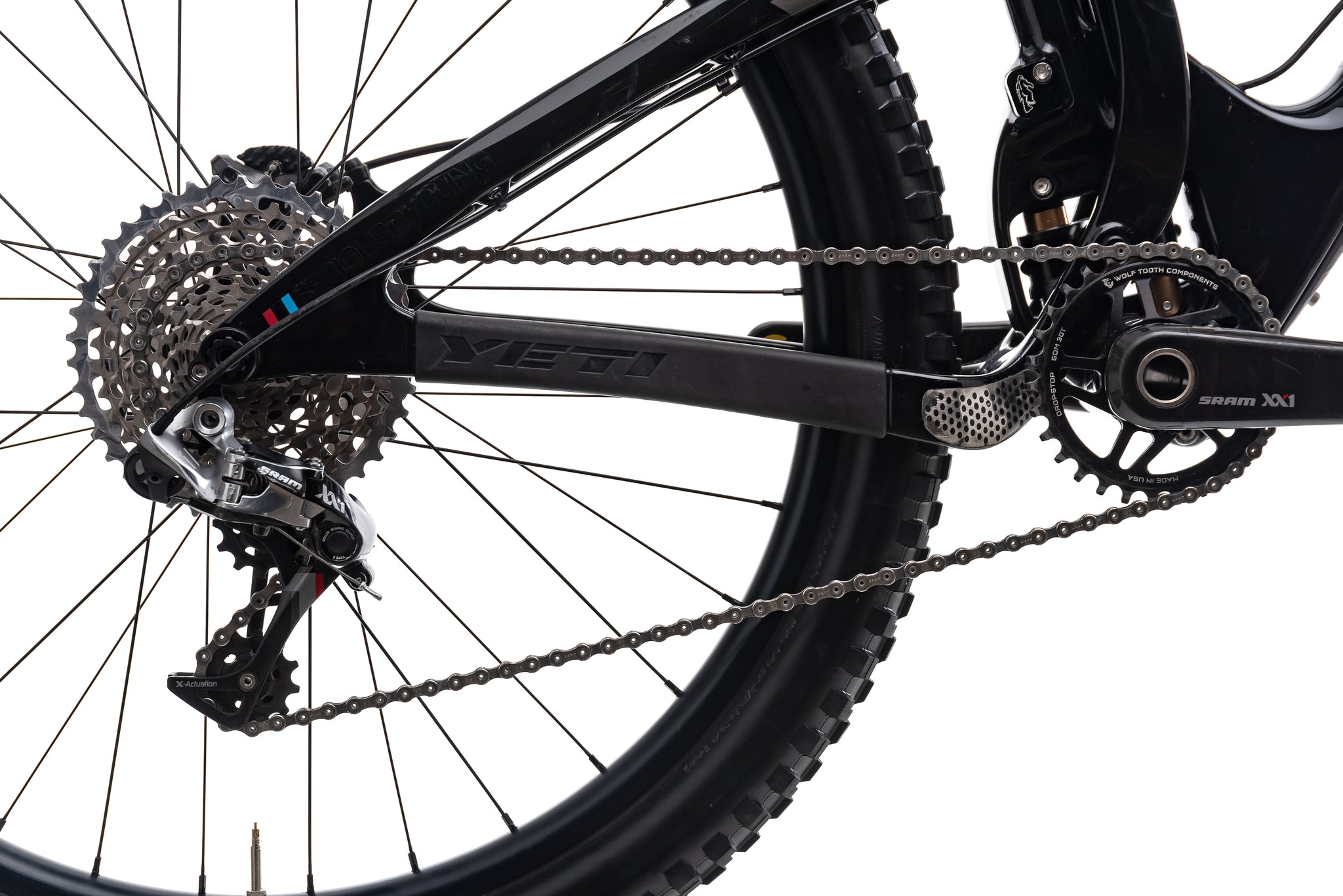 SRAM brought 1x drivetrains into the mainstream with its innovative XX1 group. Today, mountain bikes almost exclusively use single-ring drivetrains for their increased simplicity and reliability. This configuration is also prevalent on cyclocross and gravel bikes.
SRAM brought 1x drivetrains into the mainstream with its innovative XX1 group. Today, mountain bikes almost exclusively use single-ring drivetrains for their increased simplicity and reliability. This configuration is also prevalent on cyclocross and gravel bikes.
While Shimano initially resisted the move to 1x drivetrains, it has since developed more single-ring MTB drivetrain options to remain competitive. The GRX group still offers some double-chainring options for gravel bikes.
The downside for some riders using 11-speed 1x drivetrains is the reduced gear range. The release of SRAM’s 12-speed Eagle 1x drivetrains in 2016, addressed this by introducing an ample 500% gear range that has largely eliminated this issue. Three years after the release of Eagle, Shimano also released its first 12-speed mountain bike group, which provided a slightly larger 510% range.
Rear Derailleurs
 Clutch design
Clutch design
Shimano derailleurs intended for rough roads and off-road riding use its Shadow Technology, which slims the derailleur and keeps it pulled up out of harm's way. The GRX and mountain bike rear derailleurs use a friction clutch that keeps the derailleur in place on rough terrain to improve chain retention. Shimano’s clutch mechanism can be toggled on and off, mostly for easy wheel removal.
SRAM also uses a clutch on all of its mechanical 1x drivetrain derailleurs. Instead of a toggle switch, SRAM uses a cage lock which locks the derailleur cage in an extended position for wheel removal.
SRAM Orbit Damper and Overload Clutch
Traditional derailleur clutches use friction plates and springs but the latest generation SRAM AXS road and gravel derailleurs have a new hydraulic damper and hydraulic clutch system to provide chain retention. The Orbit Damper prevents movement of the derailleur on hard jarring impacts to maintain chain tension on rough roads without the full lockout provided by a clutch. The Overload clutch for AXS mountain bike derailleurs will maintain tension like a traditional clutch, but upon impact, it disengages a motor gearbox inside, giving the derailleur the freedom to move and protecting it from damage.
Shifters
Shimano STI vs. SRAM DoubleTap (Mechanical)
Shimano and SRAM take very different approaches to road bike shifter design. Shimano's STI shifters separate the control of up and downshifts into two different shift levers. The brake lever itself pivots inward to act as an up/downshift lever, and a second paddle-shaped lever sits behind it to shift in the other direction.

SRAM Red 22 HRD DoubleTap Left/Front Shifter Lever/Caliper 2x11 Speed
$213.99
Instead of two separate levers, SRAM's DoubleTap uses a single paddle-shaped lever behind the brake lever (which is fixed) to handles both up and downshifts. Pushing this lever one click inward shifts the drivetrain in one direction. Pushing the lever further in, past the first click, causes the drivetrain to shift in the opposite direction.
Both shifter designs are intuitive and have the capability to downshift multiple gears in a single lever stroke. It comes down to rider preference and ergonomics.
MTB Rapid Fire Trigger Shifters (Mechanical)
Both Shimano and SRAM use trigger-style shifters for mountain bikes. Two shift levers are housed in a pod attached to the underside of the handlebar. Both Shimano and SRAM trigger shifters can downshift multiple gears with one lever stroke.

Shimano Deore XT SL-M8100 Right/Rear Shifter 12 Speed 22.2mm Clamp
$25.99
The main difference in function is that Shimano's Rapid Fire trigger shifter features "2way-release," which allows the upshift lever to move in both directions. This means upshifts can be performed both by pushing the lever with the thumb or pulling it with an index finger.
Shimano Di2 vs. SRAM AXS (Electronic)
Shimano Di2 road and gravel shifters use two buttons on each shifter. These buttons simulate the shifters used on Shimano's STI mechanical shifters, with the right shifter controlling the rear derailleur and the left shifter controlling the front derailleur.
SRAM AXS road and gravel shifters use a single paddle on each shifter. These offer a different shifting experience: the right paddle upshifts while the left paddle downshifts. For 2x dirvetrains, pressing both paddles simultaneously shifts the front derailleur.
To learn more, jump to electronic drivetrains.
Crankarms
Crankarm Material: Hollowtech vs. Carbon
Shimano is known for its Hollowtech crankarms. Hollowtech refers to a hollow, aluminum crankarm, generally made from two halves joined together. It maintains the stiffness of a solid crankarm while significantly decreasing the weight.
For its higher-end crank offerings, SRAM uses carbon fiber. Carbon fiber is made from carbon sheets and fibers bonded in resin. It has a higher strength-to-weight ratio than steel. Entry-level and mid-range crankarms will use machined aluminum.

SRAM XX Eagle T-Type Wide Crankset
$500.00
Both materials and crank designs perform well. Carbon is more common for high-end cranks. Shimano is one of the few manufacturers that sticks to aluminum. It claims the Hollowtech II design offers the same performance as carbon with greater durability.
Spindles: Hollowtech II vs. DUB
Each brands uses a proprietary spindle design. Shimano uses Hollowtech II, which is a 24mm steel spindle. SRAM uses DUB, which is a 28.99mm aluminum spindle. The advantages and disadvantages of the different spindle designs can be debated to death and it's a topic that will require its own article.
In general, a crank from any brand will require a specific bottom bracket to be compatible with both the frame and crankarm spindle. Currently, both designs work for the majority of bottom bracket standards used on modern bikes.
Cassettes and freehubs
Proprietary Freehubs: Shimano Micro Spline vs. SRAM XD / XDr
Shimano’s Hyperglide is the most common freehub design, with many brands making wheels and hubs with compatible freehubs. For much of the 9, 10, and 11-speed era, SRAM cassettes have traditionally used the same design. This compatibility allowed riders to switch from one brand to the other without changing their wheels or hubs.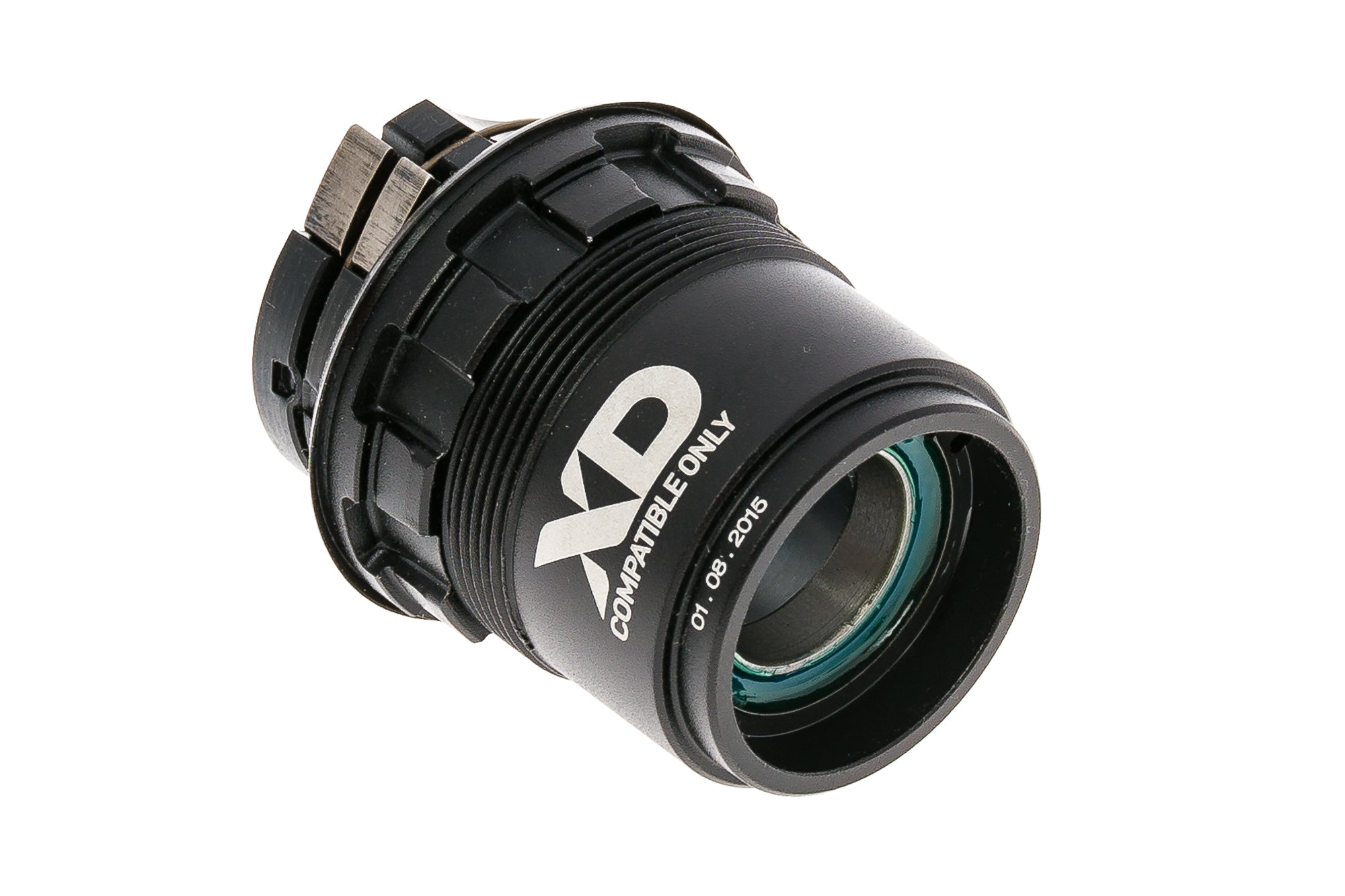
With the release of 11-speed XX1 for mountain bikes in 2012, SRAM made the bold step of releasing a proprietary freehub, the XD driver. The XD driver freehub was designed to fit the new PowerdomeX mountain bike cassettes which have a smaller 10-tooth cog. The XD Driver has remained in use for SRAM’s current 12-speed Eagle mountain bike group. SRAM has also released a road version known as XDR, which is used for its 12-speed eTap AXS road group. Essentially all modern SRAM drivetrains now use XD or XDR drivers.
Shimano has also created its own proprietary 12-speed freehub design, called Micro Spline. It is intended for its new 12-speed mountain bike group. Micro Spline is similar to XD Driver in that it allows the use of a smaller 10-tooth cassette cog, but its shape is fundamentally different. This means Shimano and SRAM’s 12-speed MTB cassettes each require a specific hub and are not interchangeable.
SRAM Powerdome and One-Piece Cassettes
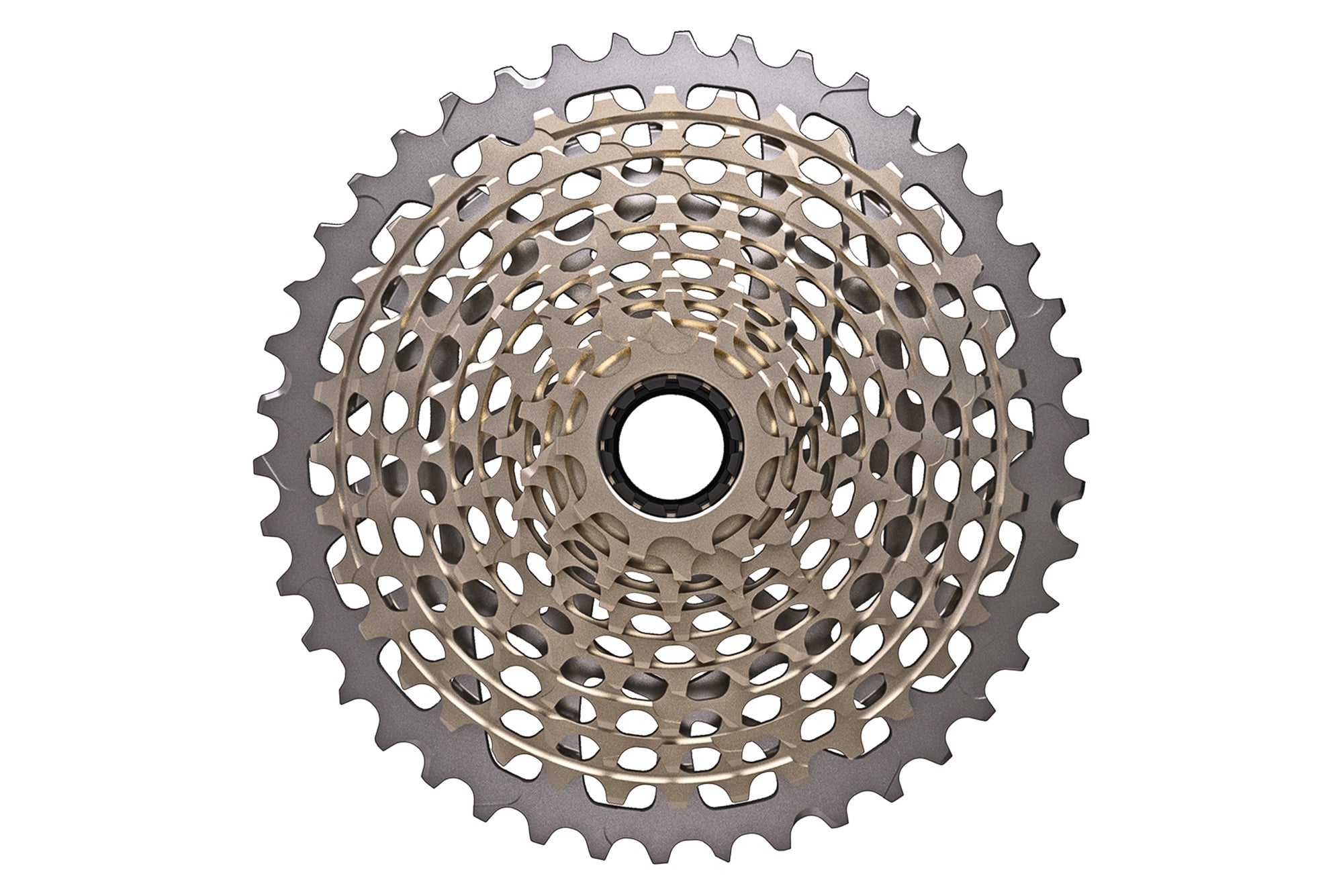 An 11-speed 10-42t SRAM XX1 PowerdomeX Cassette
An 11-speed 10-42t SRAM XX1 PowerdomeX Cassette
SRAM's latest high-end cassettes save weight over high-end Shimano cassettes by using a connected "dome" of cogs all machined from a single block of steel. However, these cassettes are far more expensive than a conventionally constructed cassette.
Shimano generally still uses the traditional cassette design with individual cogs stacked and separated by spacers or attached in clusters to aluminum carriers. SRAM’s lower-end XD Driver-compatible cassettes use individual cogs connected with pins in the same PowerdomeX layout. These are less expensive but heavier.
Electronic Drivetrains
 Electronic drivetrains are at the top of Shimano and SRAM's component hierarchies. They represent the pinnacle of their drivetrain technology.
Electronic drivetrains are at the top of Shimano and SRAM's component hierarchies. They represent the pinnacle of their drivetrain technology.
Shimano Di2
Shimano’s electronic Di2 (Digital Integrated Intelligence) drivetrain technology was first introduced in 2009 with the Dura-Ace Di2 group. It later trickled down into the more affordable Ultegra Di2 group in 2011. Di2 connects components with wires to a large central battery housed inside the bike frame.
The latest generation 12-speed Di2 groups have been updated so the derailleurs remain wired to the main battery, but the shifters are wireless, simplifying the initial setup of the system.
Di2 is only available in higher-end groups. Dura-Ace, Ultegra, and 105 (12-speed only) for road bikes. For gravel and MTB, Di2 is currently (as of Jan, 2024) only available in the previous generation 11-speed versions of GRX 800, XTR, and Deore XT.
SRAM eTap, eTap AXS, Eagle AXS, & T-Type Transmission
SRAM’s first electronic drivetrain, eTap Red, was introduced in 2015. Unlike Di2, it is fully wireless and each derailleur has its own small rechargeable battery. In 2019, SRAM introduced its latest 12-speed eTap AXS groups. These are available in Red, Force, Rival, and Apex.
Wireless shifting technology also expanded to mountain bikes in 2019 with Eagle AXS. It's available in XX1, X01, and GX.
 In 2023, SRAM advanced electronic mountain bike drivetrains once again with its Eagle AXS T-Type Transmission drivetrains, which use a direct-mount rear derailleur to improve precision, durability, and shifting under load. These are available in XX, XX, X0, and GX.
In 2023, SRAM advanced electronic mountain bike drivetrains once again with its Eagle AXS T-Type Transmission drivetrains, which use a direct-mount rear derailleur to improve precision, durability, and shifting under load. These are available in XX, XX, X0, and GX.
Wiring
The major difference between Di2 and eTap/AXS is the use of wires. Di2 components are connected by wires, usually routed internally through a bike frame. Though it is more complicated, routing Di2 is usually only a one-time job. Shifters and the rest of the system are connected by a junction box, often under the stem. Some bikes hide the junction box in the frame or handlebars, but that requires additional routing.
In 2021, Shimano introduced a semi-wireless system for Ultegra and Dura-Ace. The shifters are independent, while the battery and derailleurs are connected with wires.
eTap/AXS is wireless and transmits its signal using SRAM’s proprietary wireless protocol, Airea. The initial set-up is very quick and simple due to the lack of wires.
Batteries
Di2 uses a single rechargeable battery, which is often hidden inside the seatpost or handlebars. Older versions mount the battery externally on the frame. Di2 has 1,000-2,000km battery life. When it runs low, the front derailleur stops working to preserve rear shifting. When the battery dies, the derailleurs will remain in the gear selected, essentially functioning like a singlespeed. Battery life can be checked by holding both shift button on the right shifter, which will activate an LED battery indicator light on the junction box.
SRAM eTap/AXS requires separate batteries in each derailleur which have approximately 60 hours of battery life. The rechargeable batteries are swappable between derailleurs if one runs low, meaning you can sacrifice the front derailleur battery to maintain shifting in the rear. When the batteries die, the derailleurs remain in the gear selected. Battery life can be checked by pressing the function buttons on the derailleurs, which will activate an LED battery indicator light on the derailleur. The shifters use common CR2032 batteries that usually last several seasons. Shifter paddles have an LED battery life indicator on the inside of the paddle.
Functionality and Shift Logic
Di2 road shifters have two shift buttons on each shifter, similar to the up and downshift levers on STI mechanical shifters. SRAM's electronic road shifters have a single shift paddle on each shifter, similar to DoubleTap, but they have a notably different function. The right paddle shifts the rear derailleur up into a harder gear; the left paddle shifts down into an easier gear. Front derailleur shifts are actuated by pressing both levers simultaneously.

SRAM RED eTap AXS D1 Hydraulic Right/Rear Shifter/Brake 12 Speed
$299.99
The Di2 mountain bike shifter uses trigger-style shift levers similar to Rapid Fire shifters. Di2 mountain bike shifters come programmed with the up and downshift levers opposite of mechanical Rapid Fire shifters. This can be reprogrammed. Eagle AXS mountain bike shifters utilize a single large button that can move up or down to actuate shifts, plus an auxiliary button behind the shifter that can be pressed with your index finger. You can customize shift button functions with the AXS app.
Both Di2 and eTap AXS have satellite shifters that can be placed in different areas of the cockpit for climbing or sprinting. Both allow riders to use an app or software to customize the function of their buttons and shift action of their drivetrains.
Hydraulic Disc Brakes
 Today, essentially all Shimano and SRAM drivetrains use hydraulic disc brakes. The major differences consumers will notice are in the brake fluid used and general brake feel.
Today, essentially all Shimano and SRAM drivetrains use hydraulic disc brakes. The major differences consumers will notice are in the brake fluid used and general brake feel.
Brake Fluid: Shimano Mineral Oil vs. SRAM DOT Fluid
Shimano and SRAM brakes do not use the same fluid. Shimano uses mineral oil while SRAM uses DOT 5.1 brake fluid. Here's a quick comparison of mineral oil vs. DOT fluid:
| Mineral oil | DOT 5.1 fluid | |
| Boiling point | 480-552° F (varies based on manufacturer) | 518° F |
| Hydrophobic? | Yes | No |
| Corrosive? | No | Yes |
| Standardized? | No | Yes |
| Availability | Bike shops, some other stores | Bike shops, all auto part stores |
Mineral oil is hydrophobic, meaning it resists absorbing water in the air. The boiling points of mineral oil and DOT fluids are comparable, but the introduction of water reduces the boiling point and decreases performance. Being hydrophobic means mineral oil has a very long shelf life, and the boiling point will remain stable during the fluid’s lifespan. However, if any water does enter the braking system, it will pool at low points and compromise the whole system, requiring a full bleed. Mineral oil is non-corrosive, but it is also unregulated so manufacturers like Shimano determine the specifications of their own fluids, and there are no minimum standards.
DOT fluid is hygroscopic, meaning it can absorb water from the air over time. As it does, the boiling point will change. Because of this, open bottles of brake fluid have a limited shelf life so it’s often recommended to use opened DOT fluid within 12 months. The upside is that water won’t pool in a DOT fluid system. DOT fluid is easy to clean, which is good because it is corrosive. It can damage sensitive surfaces on your bike as well as your skin and eyes. Because DOT fluid is regulated by the Department of Transportation, it’s governed by minimum standards that regulate quality and ensure it meets certain specifications. It’s also widely available, not just in bike shops.
Lever Design and Feel
Shimano and SRAM brakes also have a different feel from each other due to the technology they use at the brake lever. Shimano brakes are generally known for having better initial bite, while SRAM brakes tend to have less bite, but more modulation.
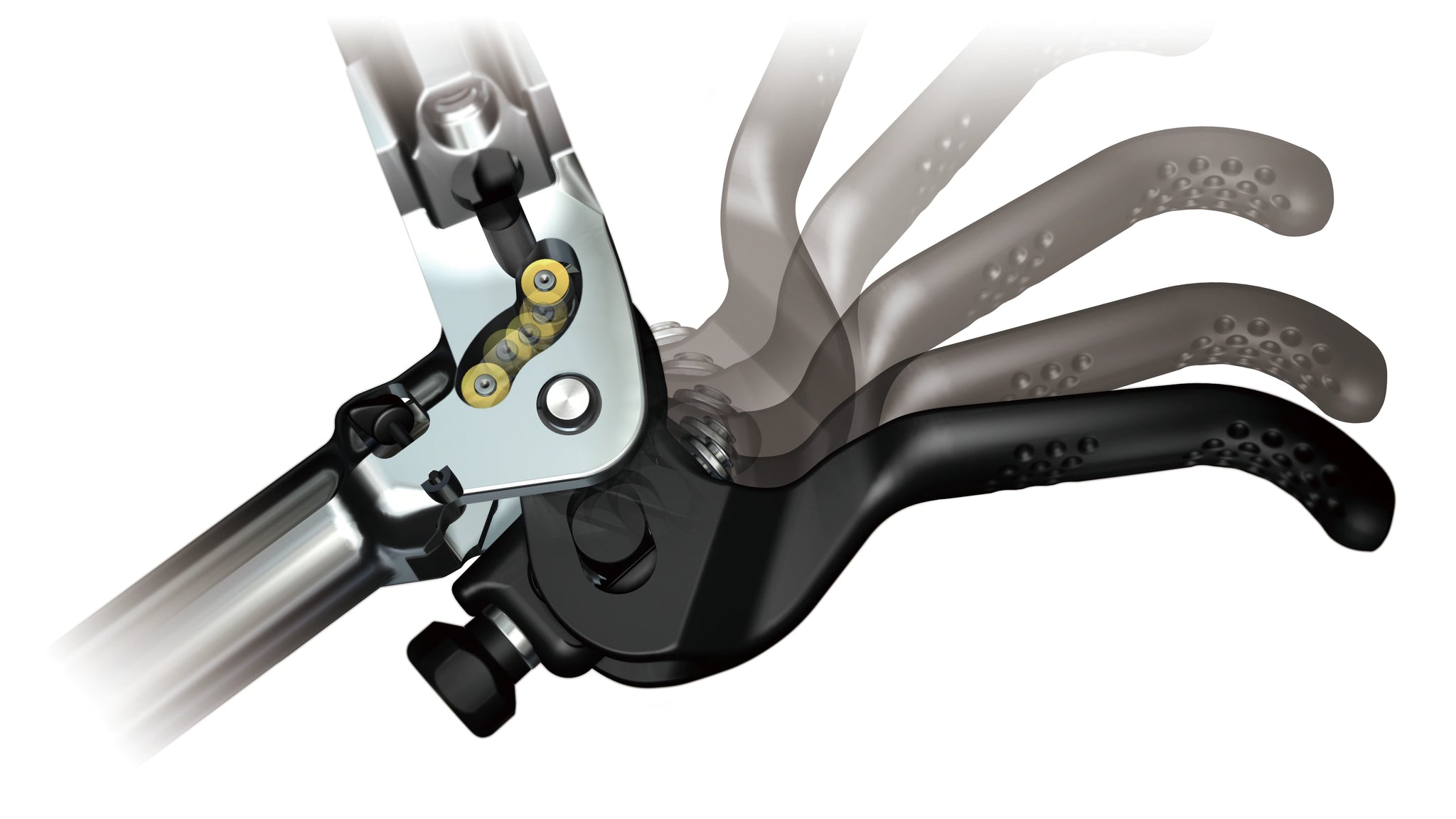 Photo Courtesy Shimano
Photo Courtesy Shimano
Shimano brakes use Servowave. With Servowave, initial pad travel is fast, so little lever movement is needed to contact the rotor. At contact, the power multiplication factor increases so more lever stroke is used to apply greater braking power. This allows the use of short, stubby MTB brake levers with less leverage. Road brake levers are also easier to pull from the hoods.
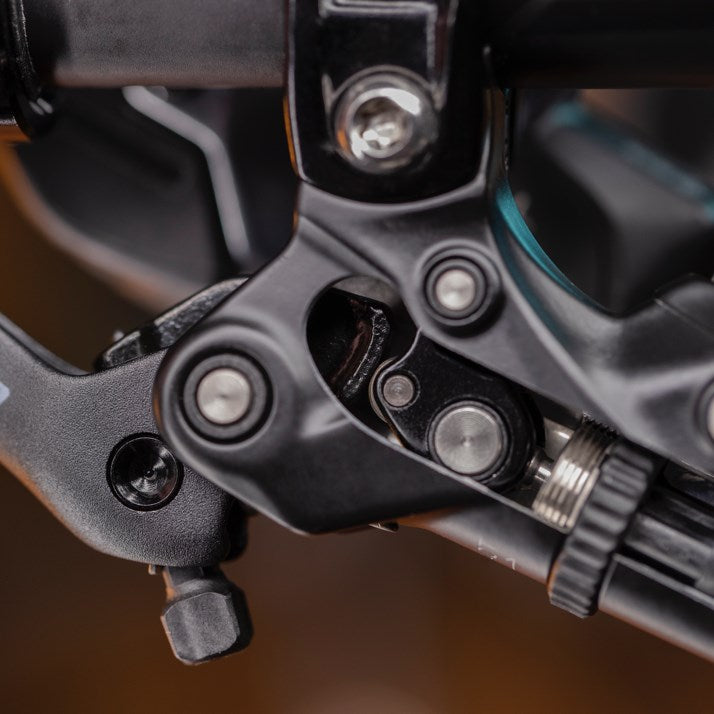 Photo Courtesy SRAM
Photo Courtesy SRAM
Higher-end SRAM brakes use Swinglink, a cam shape inside the brake lever that reduces “deadband” while increasing progressive power throughout the pull.
When riders describe the difference in how Shimano and SRAM disc brakes feel, Shimano is often described as having more of an “on or off” or “lightswitch” feeling where the braking power comes on instantaneously. SRAM brakes will tend to have a more “progressive” feel which may be easier for some riders to modulate and control. Both styles work well and it comes down to personal preference.

SRAM Level Silver Stealth 2 Piston Aluminum Lever Brake Set C1
$185.00
SRAM mountain bike brake levers are ambidextrous, meaning they can be swapped to either side of the cockpit without removing the hoses or rebleeding the system. This is a perk for riders who to switch which side their brakes are on, like myself. I often choose SRAM brakes to reduce the hassle.
History and Mission
Shimano
The Shimano story begins in 1921, 100 years ago, in Sakai, Osaka, Japan. Shimano’s founder, Shozaburo Shimano, was only 26 years old when he moved into a small rented space in a demolished celluloid factory and opened Shimano Iron Works. With a borrowed lathe, Shimano’s ambitious goal was to produce his first bicycle component: freewheels.
 Shozaburo Shimano | Photo Courtesy Shimano
Shozaburo Shimano | Photo Courtesy Shimano
At the time, freewheels were the component that took the most technology to produce. Shimano, however, was so confident in the reliability of his freewheels that he backed them with a bold guarantee — any defective freewheel would be replaced by two.
 The original Shimano freewheel | Photo Courtesy Shimano
The original Shimano freewheel | Photo Courtesy Shimano
Shozaburo Shimano led his company and developed bicycle components until his death in 1958. His son, Shozo Shimano, took over as the next president. Over the next 50 years, Shimano grew to become the world’s dominant component manufacturer, overtaking former leaders like Campagnolo and SunTour.
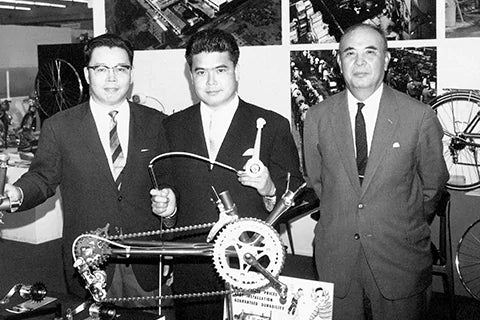 Shozo Shimano (left) at Shimano American Corporation office in New York - 1965 | Photo Courtesy Shimano
Shozo Shimano (left) at Shimano American Corporation office in New York - 1965 | Photo Courtesy Shimano
With high quality and reliable products, Shimano has established itself as a benchmark component brand in the industry. It is currently led by Shozaburo’s grandson, Yozo Shimano. With sales that constitute an estimated 70-80% of the global cycling component market by value, it is the biggest cycling component manufacturer in the world. Their stated mission is to promote health and happiness with outdoor products that help people enjoy nature and the world around us.
Annual revenue: $3.8 Billion (fiscal year 2021, bicycle division, converted from 443.7 Billion Yen based on historical exchange rate)
Employees: 11,829
Philanthropy: Shimano is one of the founding members of the EcoMobility Alliance, an international partnership of people and companies that work to improve EcoMobility.
SRAM
SRAM’s unique name is said to be an amalgamation of the names of its founders. It comes from combining letters from Scott, Ray, and Sam (Ray is the middle name of former CEO, Stan Day). Scott King was the company's attorney. Stan R. Day was SRAM’s first CEO. And Sam Patterson was an engineer and designer who created SRAM’s first product. SRAM's founder and first CEO, Stan Day | Photo Courtesy SRAM
SRAM's founder and first CEO, Stan Day | Photo Courtesy SRAM
SRAM was founded in Chicago in 1987. The company began with a single product — the Grip Shift. The Grip Shift was an indexed gear shifter that wrapped around the ends of drop handlebars. Traditionally, riders had shift levers mounted to the frame, but Grip Shift allowed riders to change gears without removing their hands from the handlebars. Sam Patterson, who at the time worked for an engine manufacturer, designed SRAM's first product.
 Early Grip Shift on a drop-bar bike | Photo Courtesy SRAM
Early Grip Shift on a drop-bar bike | Photo Courtesy SRAM
With a belief in the power of the Grip Shift, Stan Day assembled investors, set up an office, and became the company’s first president while Sam Patterson became the head of research and development. Over the next 30 years, SRAM acquired several component companies, such as RockShox, Zipp, Truvativ, Quarq, PowerTap, and Time pedals. This growth has led it to become the second-largest component manufacturer in the world with an expansive catalog of bike parts.
One of SRAM's key goals is to be the most exciting component manufacturer in the industry. It has worked toward this goal with innovative products that have produced notable shifts in the industry. A point of pride for the company has been its success in taking on Shimano, who once controlled well over 85% of the cycling component market.
Annual revenue: $974 Million (fiscal year 2020)
Employees: 3,500
Philanthropy: World Bicycle Relief (WBR) is a non-profit that specializes in large-scale, comprehensive bicycle distribution programs to aid poverty relief in developing countries.
Timeline: Key Technological Innovations
Both Shimano and SRAM have developed products that have moved cycling forward. Much of the bike technology we take for granted today is the result of Shimano's and SRAM's innovations. Here are a few key products they've developed that have helped shape modern cycling.
Shimano
1984 - Shimano Index System (SIS)
The Dura-Ace 7400 group introduced indexed shifting, which provided accurate gear changes with shifts that corresponded to clicks in the shifter. Gear changes became more precise and faster as riders could select the gear without having to fiddle with the position of a friction shifter. Indexed shifting is the basis for how modern mechanical shifters work.
1989 - Shimano Total Integration (STI) / Rapid Fire Photo Courtesy Shimano
Photo Courtesy Shimano
STI is a shifting system that allows cyclists to shift gears, operate the brakes, and steer without removing their hands from the handlebars. STI integrated shift levers into the brake hoods, creating the blueprint for modern road, cyclocross, and gravel bike shifters as we know it. Rapid Fire was a flat-bar version of STI, using a pod with trigger style levers clamped to the bar. Trigger-style shifters are now the most common type of shifter used on mountain bikes.
1990 - Shimano Pedaling Dynamics (SPD) shoes and pedals
Shimano created a standard-setting clipless shoe and pedal system. Many brands now produce pedals compatible with Shimano SPD style cleats. It is one of the most ubiquitous clipless pedal systems.
2009 - Digital Integrated Intelligence (Di2) electronic shifting
Di2 was introduced for Shimano’s Dura-Ace level group and was the first commercially viable electronic shifter and derailleur system. Di2 made electronic shifting the new standard for top-of-the-line group.
2014 - XTR Di2
Shimano brought its Di2 technology to mountain bikes with the XTR Di2 M9050 group, the first electronic mountain bike group.
2021 - Semi-wireless Di2 shifting
Refining its Di2 system, Shimano introduces Dura-Ace R9200 and Ultegra R8100 with shift levers that communicate wirelessly with the derailleurs, which remain connected to each other and the battery via wires.
SRAM
1987 - Grip Shift
SRAM's story began with an indexed gear shifter that wrapped around the handlebars. The Grip Shift design still sees use today on some mountain bikes, commuters, and other flat-bar bicycles.
2006 - DoubleTap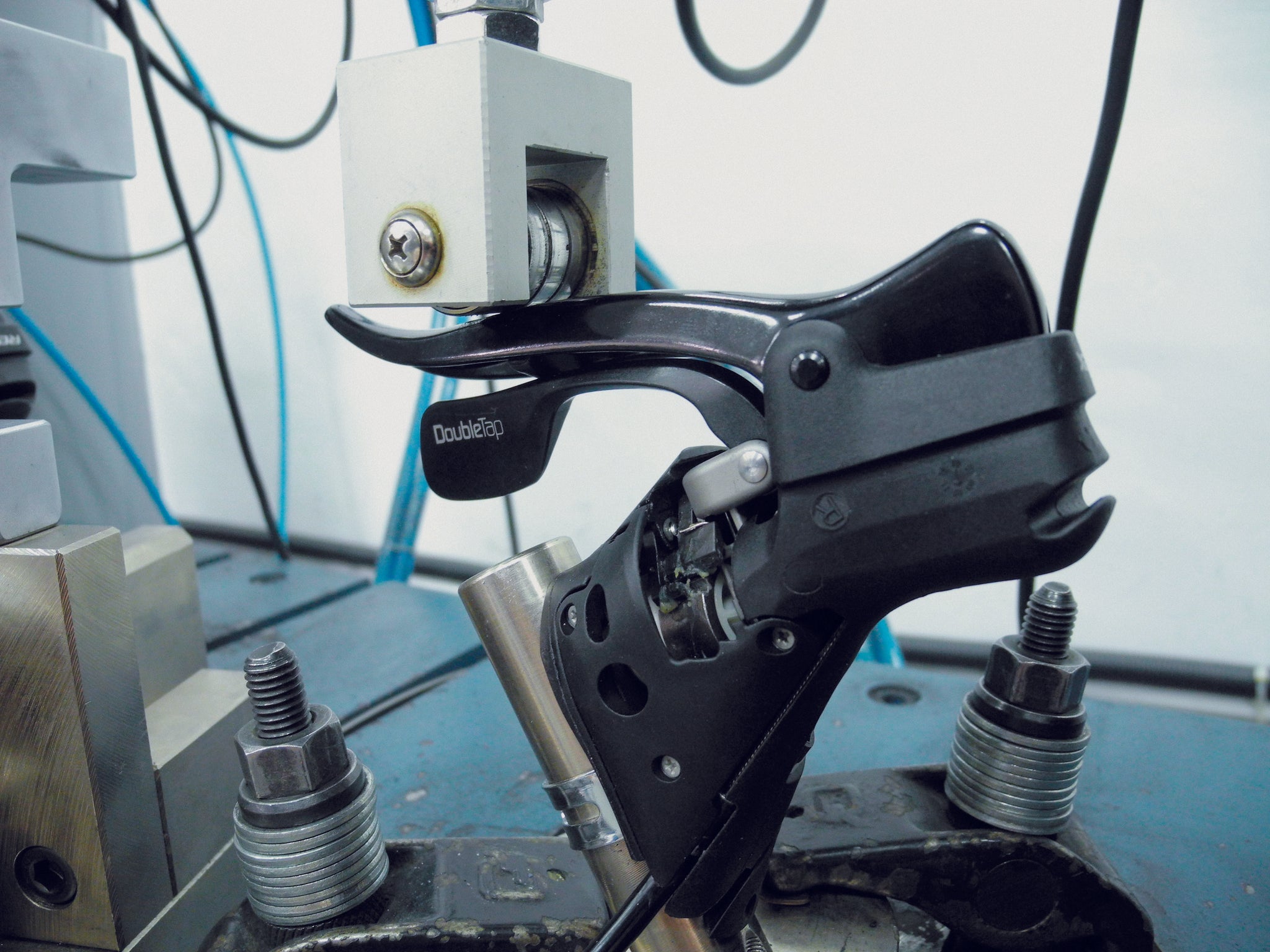
SRAM’s integrated shifting solution for road bikes allowed the rider to shift in both directions using a single shifter paddle. This was also SRAM's first foray into producing a complete road component group, Force.
2012 - 1x11 XX1 group
Riders had experimented with 1x (pronounced “one-by”) drivetrains in the past, but XX1 was the first 1x drivetrain from a major manufacturer that became a mainstream option. Like previous attempts at single-chainring drivetrains, XX1 simplified shifting by removing the front derailleur. This configuration is now the standard for most mountain bikes and is popular on cyclocross and gravel bikes as well.
2015 - Red eTap
eTap was SRAM’s first electronic road group and it set itself apart from Shimano’s Di2 system by being wireless.
2016 - 1x12 Eagle group
Eagle was the first 12-speed mountain bike group. It expanded the capabilities of SRAM’s already successful 1x11 groups with a wider 500% gear range that was comparable to traditional 2x systems.
2019 - eTap AXS and Eagle AXS
SRAM continued the progression of its wireless electronic group with AXS. AXS introduced a new 12-speed road bike group and the first wireless electronic mountain bike group.
2023 - Eagle AXS T-Type Transmission drivetrains
T-Type Transmissions introduced direct-mount rear derailleurs designed to enhance shift precision, shifting under load, and durability.
Industry Popularity
Because TPC is the world leader in buying and selling used bikes, we have substantial data about what bikes are popular and what groups they are equipped with. I dug into our recent sales looked at thousands of different bikes to analyze how Shimano and SRAM are performing in different categories.
The data presented below does not indicate that one brand is better than the other. It simply shows how bike manufacturers and owners have chosen to equip their bikes.
| Shimano | SRAM | |
| Road bikes | 76% |
18.5% |
| Gravel/cyclocross bikes | 51.1% | 46.9% |
| Mountain bikes | 27.7% | 71.5% |
This data shows that, unsurprisingly, Shimano and SRAM make up over 90% of all bike groups we sell. Campagnolo is the next largest but only contributes to a small fraction of our sales.
The data also shows some recent trends. SRAM has become the dominant choice for mountain bikes, which is likely due to the increased popularity of its 1x drivetrains. Shimano, however, has maintained a firm hold on the road bike category, which it has dominated for decades. Cyclocross and gravel bikes are split fairly evenly between Shimano and SRAM. The category is still evolving, but SRAM is gaining significant steam with is 12-speed AXS groups.
Final Thoughts
SHIMANO and SRAM both make quality products, but their approaches and styles are different. Shimano is generally the more conservative of the two. Over the last decade, SRAM has pursued drivetrain innovation more aggressively. In many cases, Shimano has been forced to respond to remain competitive.
A good example is the development of its new 12-speed 1x drivetrain in response to SRAM’s ground-breaking Eagle drivetrain. Shimano is not struggling by any means. It remains strong in all categories, and many riders choose Shimano based on its long history in the sport and strong reputation for quality.
I’ve had the good fortune to ride more bikes than the average consumer. I’ve also known many co-workers who are very loyal to their chosen brand. For these ultra-picky riders, it often comes down to small subjective details like feel, ergonomics, and looks. I’ve swapped back and forth countless times.
Your preferences are likely to evolve and change as you spend time riding one brand or the other. Many riders become accustomed to what they know and find it hard to switch brands. Others can jump back and forth without a second thought. Where ever your loyalties lie, the important thing is that you’re on a bike that you love riding.
Do you have a preference for Shimano or SRAM? Are you a Campy fan who feels left out? Let us know in the comments!


